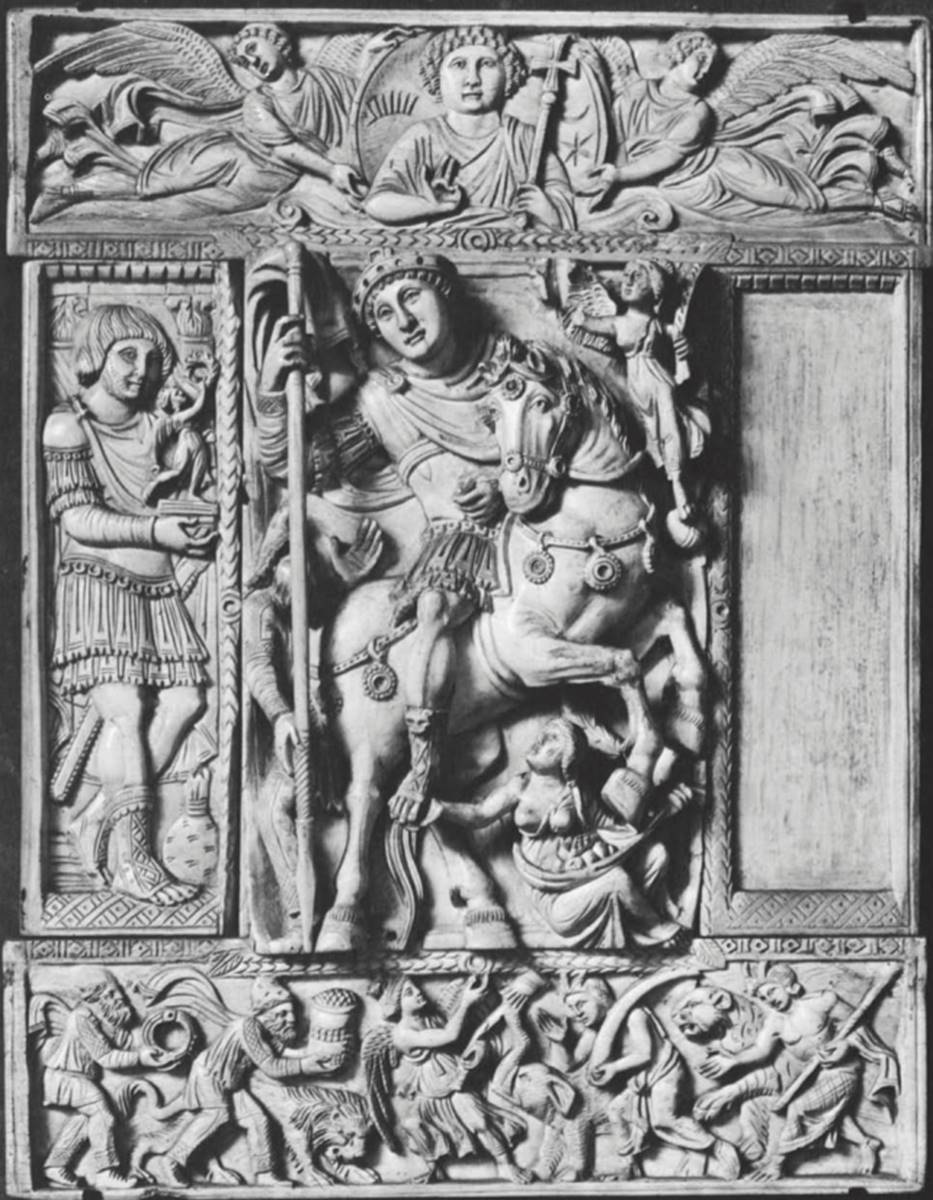Diptych leaf with Justinian as Defender of the Faith
Four panels survive of the five-part wing of an imperial diptych, a type introduced in the fifth century. Breaks in the left edges of the upper and lower panels indicate location of hinges, where side panel was lost. Other than these breaks, and loss of the projecting right arm of Victory at the top of the central panel, carved areas are in good condition. Because the barbarian in the central panel has no carved left leg, Delbrueck (1929) assumed the work was originally painted. In upper panel, a beardless Christ in bust form occupies a clipeus supported by two flying angels; in the disc are inscribed the rising sun on his right, the crescent moon and a star on his left. In the left hand he holds a cross-scepter, while he blesses with the right.

The blessing is bestowed on the dominant figure in the center panel, a crowned and cuirassed emperor on a rearing horse, holding in his right hand a lance with point thrust to the ground. Behind this lance stands a barbarian, touching the lance and raising his left hand in gesture of submission. In the lower left is a seated female, personifying Terra, holding her fruits and touching the emperor's foot—another gesture of submission. In the upper left, a flying Victory bears a palm frond; her lost right hand probably held a crown.
The left-hand panel depicts a standing military figure, who offers a figure of Victory; a similar offering was doubtless made in the missing panel opposite. The lower panel has Victory holding a tropaion and gesturing to barbarians and various other exotics, including the fiercest of animals— lion, elephant, and tiger—all offering homage.
The iconography is the traditional one of imperial victory; only the upper panel indicates a Christian aspect. Because such representations no longer depicted specific events, the ivory cannot be associated with any particular war or imperial triumph.
Analysis of the style of the work has led to conspicuous disagreement. Delbrueck's suggestion (1929) of close similarity with the diptychs of Areobindus (consul in 506) seems less persuasive than the comparison to the Maximianus cathedra in Ravenna (Volbach, 1976, no. 140), now generally considered a product of Constantinopolitan workshops under Justinian. The radical difference in technique between the central panel, with its deeply undercut relief, and the more restrained modeling of the other parts, bears comparison with the wide stylistic disparities between the three main categories of panels on the throne. The emperor bears a certain resemblance to the Con- stantinians and is most likely symbolic of Justinian as victorious conqueror in the name of Christ.
Although clearly a product of the East, the ivory found its way to the West at an early date, and was probably in Trier in the seventh century. Its subsequent history is unknown until 1625, when Nicolas-Claude Fabri de Peiresc gave it to the Cardinal Legate Francesco Barberini in Aix-en- Provence already in its present form. It was acquired by the Louvre at the Barberini auction in Paris in 1899.
Bibliography: Delbrueck, 1929, no. 48; Grabar, 1957, pp. 24-26; Coche de la Ferte, 1958, no. 22; Calza, 1972, no. 222; Volbach, 1976, no. 48.
Date added: 2025-07-10; views: 188;
